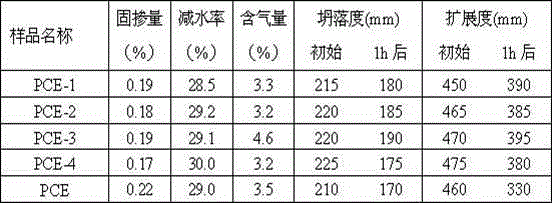Polycarboxylic super plasticizer
A technology of superplasticizer and polycarboxylic acid, applied in the field of concrete admixtures, can solve the problems of reducing the space resistance between cement particles and particles, unfavorable polycarboxylate superplasticizer dispersibility and dispersion retention, etc. Effects of performance, reduced contact, good dispersion and dispersion retention
- Summary
- Abstract
- Description
- Claims
- Application Information
AI Technical Summary
Problems solved by technology
Method used
Image
Examples
Embodiment example 1
[0027] Add 432g of A1 and 310.5g of water into a 1000ml four-necked flask equipped with a stirrer, a thermometer, and a dropping device, and stir to raise the temperature to 60°C. Add 2.50g of 30% concentration of hydrogen peroxide, start to drop 50.0g of initiator aqueous solution (obtained by dissolving 1.50g of sodium ascorbate and 2.5g of 3-mercaptopropionic acid in 46g of water), then add dropwise 80.0g of monomer aqueous solution (from 51.8 g B1 monomer was dissolved in 28.2g water) and 48.0g of N-vinylpyrrolidone aqueous solution (obtained by dissolving 4.0g N-vinylpyrrolidone in 44.0g water), the initiator dropping time was controlled at 210 minutes, the monomer The dropwise addition time of the aqueous solution and the N-vinylpyrrolidone aqueous solution is controlled at 180 minutes, and the reaction temperature is controlled at 58-62°C. After the dropwise addition, keep the temperature at 58-62°C for 60 minutes to complete the polymerization reaction. After the hea...
Embodiment example 2
[0029] Add 408g of Al and 298g of water into a 1000ml four-necked flask equipped with a stirrer, a thermometer, and a dropping device, and stir to raise the temperature to 60°C. Add 3.0g of 30% concentration of hydrogen peroxide, start dropwise adding 50g of initiator aqueous solution (obtained by dissolving 1.50g of sodium ascorbate and 2.8g of 3-mercaptopropionic acid in 45.7g of water), then add dropwise 120.0g of monomer aqueous solution (from 42.8 g B1 monomer, 35.2g C1 monomer dissolved in 42g of water) and 40.0g of N-vinylpyrrolidone aqueous solution (obtained by dissolving 9.5g of N-vinylpyrrolidone in 30.5g of water), the initiator dropping time is controlled at 210 minutes, the dropwise addition time of monomer aqueous solution and N-vinylpyrrolidone aqueous solution is controlled at 180 minutes, and the reaction temperature is controlled at 58-62°C. After the dropwise addition, keep the temperature at 58-62°C for 60 minutes to complete the polymerization reaction. ...
Embodiment example 3
[0031] Add 396g of A2, 16g of B2, and 325g of water into a 1000ml four-necked flask equipped with a stirrer, a thermometer, and a dropping device, and stir to raise the temperature to 65°C. Add 3.0g of 30% concentration of hydrogen peroxide, start dropwise adding 50g of initiator aqueous solution (obtained by dissolving 1.50g of sodium ascorbate and 2.5g of 3-mercaptopropionic acid in 46g of water), and then add dropwise 90.0g of monomer aqueous solution (from 35.6g B1 monomer was dissolved in 54.4g water) and 50.0g of N-vinylpyrrolidone aqueous solution (obtained by dissolving 11g N-vinylpyrrolidone in 39g water), the initiator dropping time was controlled at 240 minutes, monomer aqueous solution and N - The time for adding the vinylpyrrolidone aqueous solution is controlled at 210 minutes, and the reaction temperature is controlled at 63-67°C. After the dropwise addition, keep the temperature at 63-67°C for 60 minutes to complete the polymerization reaction. After the heat ...
PUM
 Login to View More
Login to View More Abstract
Description
Claims
Application Information
 Login to View More
Login to View More - R&D
- Intellectual Property
- Life Sciences
- Materials
- Tech Scout
- Unparalleled Data Quality
- Higher Quality Content
- 60% Fewer Hallucinations
Browse by: Latest US Patents, China's latest patents, Technical Efficacy Thesaurus, Application Domain, Technology Topic, Popular Technical Reports.
© 2025 PatSnap. All rights reserved.Legal|Privacy policy|Modern Slavery Act Transparency Statement|Sitemap|About US| Contact US: help@patsnap.com

